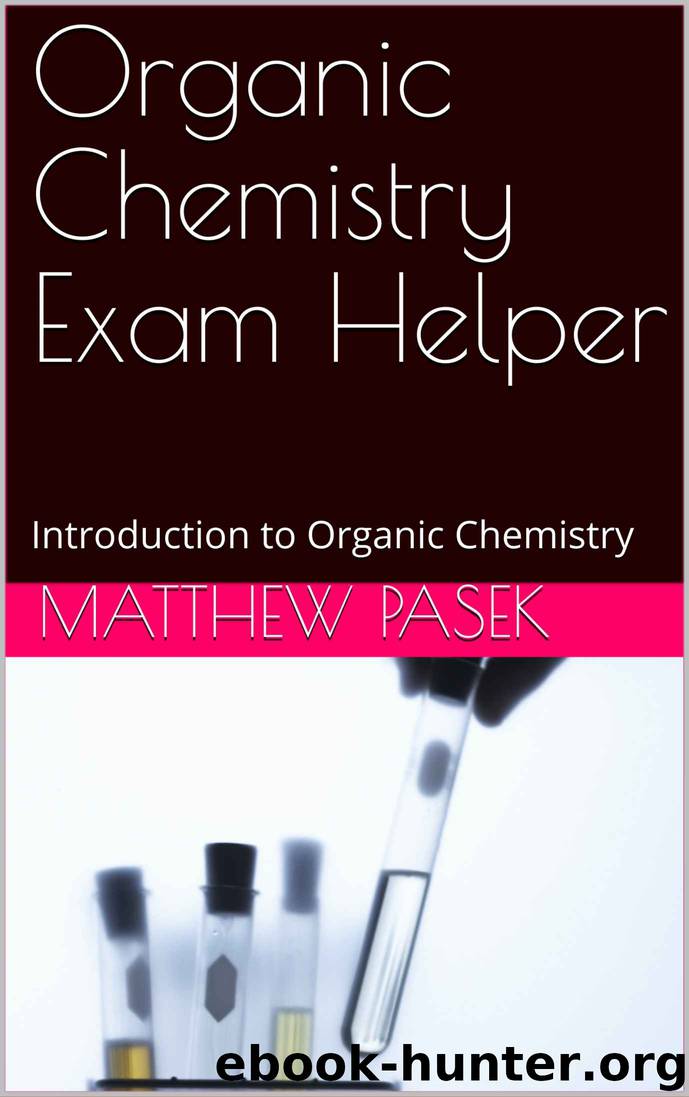Organic Chemistry Exam Helper: Introduction to Organic Chemistry by Matthew Pasek

Author:Matthew Pasek [Pasek, Matthew]
Language: eng
Format: azw3
Published: 2017-09-17T04:00:00+00:00
KEY POINTS AND HINTS:
Stereoisomers are like conformation isomers, if you break down the molecule to a descriptive sentence, there’s no way of distinguishing between stereoisomers, compared to conformational isomers.
Stereoisomers for alkenes change physical properties, but for alkanes don’t change as much.
12. Molecular Attractive Forces
Recall again from general chemistry that there are several varieties of molecular attractive forces. Most molecular attractive forces are related to the polarity of molecules—how much one side of a molecule is charged compared to the other side. The polarity of a molecule is expressed in its dipole moment, which is a vector that describes the direction and strength of charge in a molecule. The dipole moment is the sum of individual bond dipole moments. In general, the stronger the dipole moment of a molecule, the stronger its intermolecular forces of attraction.
Intermolecular forces are those forces between separate molecules. Think of an interstate (in the US). These roads nominally take you across at least two states, sometimes more (and occasionally less- there are interstates in Hawaii! Let’s just ignore those). In contrast, intra- means within something, so intrastate is a road stuck in one state, and intramolecular forces are those that occur only within the molecule.
The dipole moment of a molecule is dependent on both its shape and on its functional groups. C-N single bonds and C-H bonds have the weakest dipoles and can generally be considered nonpolar. C-O and C=O bonds are moderately and very strong, respectively. C-X bonds can be quite strong, where X is a halogen, though C-I bonds are weaker than C-F, C-Cl, and C-Br. N-H and O-H bonds have a strong dipole. One of the strongest commonly encountered organic dipole moments is a C-N triple bond.
A special variety of molecular forces are hydrogen bonds. These are discussed in detail in section 13.
A variety of molecular forces important to organic chemistry are the induced dipoles. Induced dipoles happen as the electrons move around a molecule randomly, and another molecule happens to approach. These molecules then induce a dipole in each other and stick together better than they would if the electrons didn’t move around. This effect is also known as the London Dispersion Force. It is more important for big molecules than for small molecules, as it’s easier to induce a dipole somewhere on a big (or long) molecule than on a smaller molecule. The effect of these forces is that many molecules stick together more than would be predicted by their weight alone.
Download
This site does not store any files on its server. We only index and link to content provided by other sites. Please contact the content providers to delete copyright contents if any and email us, we'll remove relevant links or contents immediately.
Alchemy and Alchemists by C. J. S. Thompson(3298)
The Elements by Theodore Gray(2854)
The Club by A.L. Brooks(2748)
How to Make Your Own Soap by Sally Hornsey(2744)
Drugs Unlimited by Mike Power(2486)
Wheels of Life by Anodea Judith(1921)
Cracking the Sat French Subject Test, 2013-2014 Edition by The Princeton Review(1768)
Perfume by Jean-Claude Ellena(1742)
The Flavor Matrix by James Briscione(1715)
Cracking the LSAT, 2012 Edition by Princeton Review(1694)
The Cosmic Machine: The Science That Runs Our Universe and the Story Behind It by Scott Bembenek(1693)
MCAT Physics and Math Review by Princeton Review(1568)
1000 Multiple-Choice Questions in Organic Chemistry by Organic Chemistry Academy(1568)
The Thing Around Your Neck by Chimamanda Ngozi Adichie(1488)
Cracking the SAT Premium Edition with 6 Practice Tests, 2017 by Princeton Review(1480)
Handbook of Modern Sensors by Jacob Fraden(1479)
A is for Arsenic: The Poisons of Agatha Christie (Bloomsbury Sigma) by Kathryn Harkup(1457)
Synchrotron Light Sources and Free-Electron Lasers by Eberhard J. Jaeschke Shaukat Khan Jochen R. Schneider & Jerome B. Hastings(1455)
Harry Potter All Books: 8 Books by J.k.rowling(1437)
